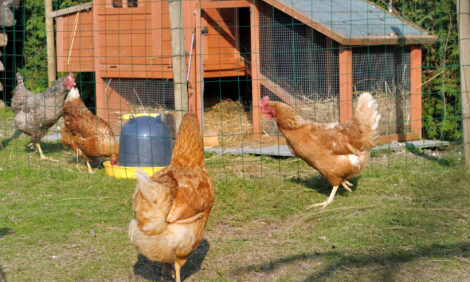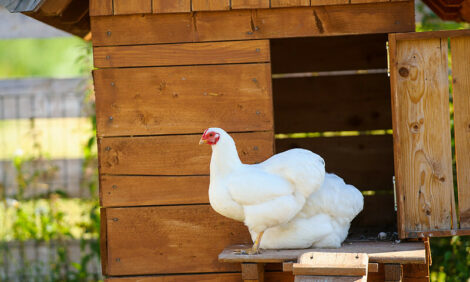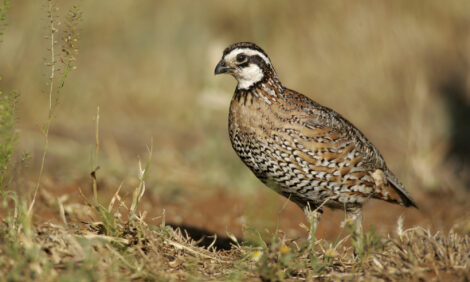



US Poultry Industry Manual - Euthanasia and flock disposal in backyard poultry
Learn more about depopulating a flock in case of a disease outbreakEditor's Note: The following content is an excerpt from Poultry Industry Manual: The Foreign Animal Disease Preparedness and Response Plan (FAD PReP)/National Animal Health Emergency Management System (NAHEMS) Guidelines which is designed to provide a framework for dealing with an animal health emergency in the United States. Additional content from the manual will be provided as an article series.
In the event of a disease control taskforce to contain and eliminate an exotic disease outbreak, such as AI or END, backyard poultry facilities present a wide array of challenges to the euthanasia and disposal crews. As previously explained, backyards are as varied and different in size, design, and content from each other as there numbers of such places. Some backyards are highly organized, very neat and orderly, well-cleaned, and maintained. Also, there is the opposite extreme and every conceivable arrangement in between the two. Each backyard, as it is designated for depopulation, must be assessed and a strategy devised for catching, euthanizing, and disposing of the birds.
Backyards frequently contain a wide range of other items, such as inoperative cars (sometimes with trees growing up through them), used or inoperative equipment, and materials of all types, sizes and amounts, refuse that has been disposed of by placing it in “storage” in the backyard, and myriads of any and all other things collectively referred to as junk, trash, or clutter. This, combined with the fact that chickens and other birds frequently are allowed to roam freely about the premises, presents various challenges for capturing loose birds for euthanasia and preventing their escape to other premises. At the same time, such conditions potentially may present additional hazards to the depopulation and disposal crew.
During the pre-depopulation assessment, these potential hazards can be noted and any additional equipment for safety and/or capturing the birds (such as fishing dip nets or chicken leg snaring rods) that may be needed can be obtained. In some places, it may be impossible to catch large numbers of loose birds. In that case, the option of doing the depopulation after dark when the birds are roosting in trees, or elsewhere among the items present in that backyard and could more easily be caught could be considered. Sometimes, may have a dog(s) that usually will ignore loose chickens in the facility, but if given the signal by the owner, these same dog(s) will be thoroughly delighted to catch and retrieve the loose chickens. That system is routinely used by owners where loose chickens regularly are free to move about the facility. Each backyard premises will present its own set of circumstances and challenges that will have to be evaluated and accommodations made to fit the conditions.
Once birds are caught, they are carried to the euthanasia station located as near as feasible to where the birds are housed. The euthanasia station consists of cylinders of compressed CO2 mounted onto carts, and some of the heavyweight plastic or cardboard barrels with plastic trash bag liners. CO2 is administered into this chamber via a hose introduced through a hole the same size as the hose through one of the barrel lids that has been specially modified, such that the hose from the CO2 tank can be introduced inside the barrel. As the barrel is filled with poultry carcasses, the bag is closed and the modified barrel lid is replaced by a regular lid that is secured onto the barrel with the special locking metal band. The barrels are then disposed of in a landfill or as determined by taskforce management. Other similar systems and methods of applying CO2 and disposal of the carcasses may be used.
There are five basic methods for disposal of backyard poultry carcasses: bury, burn, render, landfill, or compost. For commercial premises, strong consideration should be given to disposal by composting, either on-site in the same houses the poultry were in at the time of euthanasia, or at another acceptable site. Disposal of poultry euthanized by a disease control taskforce has been, as was the case in the 2002-03 California END Taskforce, by using a landfill that will accept dead poultry. At the onset of the taskforce, the Planning Section should make determinations as to what disposal method(s) will be used and determine protocols to follow.
In the California taskforce (2002-03), carcasses were initially placed in heavy weight trash bags and “double bagged” to prevent bags leaking or tearing open. Later on, this method was revised to include placing carcasses in double plastic bags inside of heavyweight cardboard barrels with metal lids and a special type metal ring and latch device to seal the barrels. Filled barrels were placed in a roll-off dumpster container which was later loaded onto semi- trucks for transfer to landfills. Barrels were then buried in the landfill. As trucks left the landfill, drivers sprayed the wheels and wheel wells with a disinfectant solution.
Appraisal and compensation for depopulated animals
At the time a backyard premises is designated for depopulation, this assignment will be given to the depopulation crew. Sometimes the depopulation crew includes a person designated as the appraiser. In this case, when the crew arrives at the , the designated appraiser will consult with the owner to determine a count of each type of bird on the premises and then establish an appraisal value. When the appraisal was completed and the owner had signed the forms, depopulation began.
Owners received payment for their birds at some later date, generally 1-2 months after the paperwork was processed. An alternate method was to send the appraiser to the premises in advance of the depopulation team. During the 2002-03 California END Taskforce, this latter method was rarely used due to limitations in the numbers of trained personnel available to do appraisals and the large number of depopulation and disposal teams operating in the field. In that case, depopulation team leaders usually were quickly trained and tasked with the appraisal process. Guidelines were provided by taskforce management about the value and limits of appraised value of various types of poultry and other birds.
Cleaning and disinfection
As soon as possible following depopulation and disposal of the birds, a team should be assigned to visit the backyard premises to clean and disinfect and to remove and dispose of contaminated materials that cannot be cleaned. The objective of backyard cleaning and disinfection is to reduce the potential for virus spread from an infected or dangerous contact premises. Cleaning and disinfecting activities on such premises should be limited to areas inhabited by, or exposed to, poultry. Task Force on-site supervisors should evaluate each premises with this objective in mind and make a reasonable determination as to whether materials can be effectively cleaned and disinfected or should be discarded. In general, cleaning and disinfection crews will follow guidelines established by taskforce management. The following general guidelines (10) may be helpful, especially in the initial phases of the outbreak:
Materials commonly found in backyards generally fall into three categories:
- Structures: Rooms and pens/cages
- Clutter: Items that are not structures for housing birds and require judgment as to whether they can be cleaned and disinfected effectively or must be discarded
- Trash: Items that impede the cleaning process and should be discarded.
The following items should be considered for disposal instead of disinfection:
- Rotten, unglued, splintered, broken, insect- (termites) infested, or otherwise unsound wood that cannot be cleaned and disinfected;
- Deteriorating chipboard or particleboard;
- Plastics and other materials that are damaged with grooves, deep gouges, cracks, split, slits, or that are broken or otherwise structurally unsound;
- Tarps that are torn, shredded, contaminated with feces, or have exposed fibers
- Metal items that cannot be easily cleaned and disinfected. Some large metal items (e.g. appliances, car bodies, and lawn mowers), should be cleaned and disinfected as thoroughly as possible and left on-site
- Porous materials that will require excessive effort to clean and disinfect
- Other materials with surfaces that are likely to harbor contamination
- Clutter that may be perfectly sound but cannot be effectively disinfected. These items may include carpet, cardboard, feed, and bedding material
- Open feed bags or containers (closed impermeable bags of feed may be sprayed with disinfectant and removed from the contaminated area
- Trash (anything of no value that cannot be cleaned). Examples of trash include empty bottles, milk cartons, aluminum cans, and paper
Wildlife management
The role that wildlife and wild birds, including waterfowl, other migratory birds, pigeons, and other non-migratory birds, may play regarding disease in backyard poultry remains controversial. Potential roles for these species should be considered early in an outbreak by disease control management authorities and appropriate protocols for managing wildlife should be adopted.
Reference: "USDA APHIS | FAD Prep Industry Manuals". Aphis.Usda.Gov. 2013. https://www.aphis.usda.gov/aph...
The manual was produced by the Center for Food Security and Public Health, Iowa State University of Science and Technology, College of Veterinary Medicine, in collaboration with the USDA Animal and Plant Health Inspection Service through a cooperative agreement.














